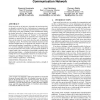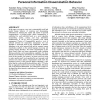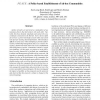218 search results - page 19 / 44 » A framework for community identification in dynamic social n... |
ICWSM
2010
13 years 9 months ago
2010
The spread of influence among individuals in a social network can be naturally modeled in a probabilistic framework, but it is challenging to reason about differences between vari...
KDD
2008
ACM
14 years 8 months ago
2008
ACM
Social networks are of interest to researchers in part because they are thought to mediate the flow of information in communities and organizations. Here we study the temporal dyn...
KDD
2005
ACM
14 years 8 months ago
2005
ACM
In this paper, we propose a new way to automatically model and predict human behavior of receiving and disseminating information by analyzing the contact and content of personal c...
ACSAC
2004
IEEE
13 years 11 months ago
2004
IEEE
Ad-hoc networks are perceived as communities of autonomous devices that interconnect with each other. Typically, they have dynamic topologies and cannot rely on a continuous conne...
CSCW
2006
ACM
14 years 1 months ago
2006
ACM
Task dependencies drive the need to coordinate work activities. We describe a technique for using automatically generated archival data to compute coordination requirements, i.e.,...



